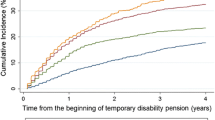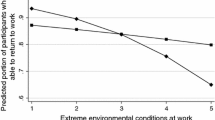Abstract
In Germany, the proportion of foreign national residents receiving an invalidity pension is higher than that of Germans. Lower utilization and effectiveness of medical rehabilitation are presumed to be the main reasons. We aimed to examine whether differences in utilization and effectiveness of medical rehabilitation between Germans and foreign nationals are attributable to differences in socio-demography, socio-economic background and health status. Utilization of rehabilitation was analyzed for household members aged 18 years or above enrolled in the German Socio-Economic Panel in 2002–2004 (n = 19,521). Effectiveness of rehabilitation was defined by the occupational performance at the end of rehabilitation. It was examined by using an 80% random sample of all completed medical rehabilitations in the year 2006 funded by the German Statutory Pension Insurance Scheme (n = 634,529). Our study shows that foreign nationals utilize medical rehabilitation less often than Germans (OR = 0.68; 95%-CI = 0.50; 0.91). For those who do, medical rehabilitation is less effective (OR for low occupational performance = 1.50; 95%-CI = 1.46; 1.55). Both findings are only partially attributable to socio-demographic, socio-economic and health characteristics: After adjusting for these factors, ORs for utilization and low occupational performance were 0.66 (95%-CI = 0.49; 0.90) and 1.20 (95%-CI = 1.16; 1.24), respectively. It can be concluded that differences in the utilization and effectiveness of medical rehabilitation between Germans and foreign nationals cannot be explained only by socio-economic differences or poorer health before rehabilitation. In addition, factors such as the ability of the rehabilitative care system to accommodate clients with differing expectations, and migrant-specific characteristics such as cultural differences, seem to play a role.
Similar content being viewed by others
References
Statistisches Bundesamt. Bevölkerung und Erwerbstätigkeit. Bevölkerung mit Migrationshintergrund. Ergebnisse des Mikrozensus 2007. Wiesbaden: Statistisches Bundesamt; 2009.
Razum O, Zeeb H, Meesmann U, Schenk L, Bredehorst M, Brzoska P, et al. Migration und Gesundheit. Berlin: Robert Koch-Institut; 2008.
Höhne A. Erwerbsminderungsrenten und medizinische Rehabilitation in Deutschland unter Berücksichtigung des Migrationshintergrunds. In: Berlin G, editor. Dokumentation 12. bundesweiter Kongress Armut und Gesundheit Präventionen für Gesunde Lebenswelten—Soziales Kapital’ als Investition in Gesundheit. Berlin: Gesundheit Berlin e.V.; 2007.
Meinlschmidt G. Gesundheitsberichterstattung Berlin. Basisbericht 2006/2007. Daten des Gesundheits- und Sozialwesens. Berlin: Senatsverwaltung für Gesundheit, Umwelt und Verbraucherschutz; 2007.
Rommel A. Migration und Rehabilitation psychischer Erkrankungen—Perspektiven und Grenzen einer Gesundheitsberichterstattung mit Routinedaten. Gesundheitswesen. 2005;67:280–8.
Korporal J, Dangel B. Die Gesundheit von Migrantinnen und Migranten als Voraussetzung für Beschäftigungsfähigkeit im Alter. Expertise für den 5. Altenbericht der Bundesregierung. 2004.
Hackhausen W. Arbeitsmigration und soziale Absicherung in Deutschland. In: Dettmers C, Albrecht NJ, Weiller C, editors. Gesund-heit, Migration, Krankheit. Sozialmedizinische Probleme und Aufgaben in der Nervenheilkunde. Bad Honnef: Hippocampus; 2002. p. 221–39.
Mösko M, Schneider J, Koch U, Schulz H. Beeinflusst der türkische Migrationshintergrund das Behandlungsergebnis? Ergebnisse einer prospektiven Versorgungsstudie in einer stationären Rehabilitation von Patienten mit psychischen/psychosomatischen Störungen. Psychother Psychosom Med Psychol. 2008;58:176–82.
Maier C, Razum O, Schott T. Migration und rehabilitative Versorgung in Deutschland—Inanspruchnahme von Leistungen der medizinischen Rehabilitation und Rehabilitationserfolg bei Personen mit türkischem Migrationshintergrund. In: Muthny FA, Bermejo I, editors. Interkulturelle Medizin. Laientheorien, Psychosomatik und Migrationsfolgen. Köln: Deutscher Ärzte Verlag; 2008. p. 85–103.
Nickel C, Lojewski N, Muehlbacher M, Cangoez B, Muller-Rabe T, Buschmann W, et al. Behandlungsergebnisse stationärer psychosomatischer Rehabilitation bei türkischen Migranten: Eine prospektive Studie. Gesundheitswesen. 2006;68:147–53.
Schmeling-Kludas C, Fröschlin R, Boll-Klatt A. Stationäre psychosomatische Rehabilitation für türkische Migranten: was ist realisierbar, was ist erreichbar? Rehabilitation (Stuttg). 2003;42:363–70.
Deutsche Rentenversicherung Bund. Rehabilitationen 2008. Berlin: Deutsche Rentenversicherung Bund; 2009.
Wagner GG, Frick JR, Schupp J. The German Socio-Economic Panel Study (SOEP)—scope, evolution and enhancements. Berlin; 2007. Report No.: 1.
Brauns H, Scherer S, Steinmann S. The CASMIN educational classification in international comparative research. In: Hoffmeyer-Zlotnik J, Wolf C, editors. Advances in cross-national comparison. New York: 2003. p. 221–244.
Elias P. Occupational classification (ISCO-88): concepts, methods, reliability, validity and cross-national comparabilty. OECD Publishing; 1997. Report No.: 20.
Grabka MM. Codebook for the $PEQUIV File 1984–2006. CNEF Variables with Extended Income Information for the SOEP. Berlin: Deutsches Institut für Wirtschaftsforschung; 2007. Report No.: 21.
Grabka MM, Frick JR. Imputation of item-non-response on income questions in the SOEP 1984–2002. DIW ResearchNote No 29 2003.
Ware JE, Jr., Sherbourne CD. The MOS 36-item short-form health survey (SF-36). I. Conceptual framework and item selection. Med Care 1992 Jun;30(6):473–83.
Bengel J, Koch U. Grundlagen der Rehabilitationswissenschaften: Themen, Strategien und Methoden der Rehabilitationsforschung. Berlin: Springer; 2000.
Bestmann A. Datenquellen und Datenqualität der Reha-Statistik-Datenbasis. In: Deutsche Rentenversicherung Bund, editor. Tagungsband Bericht über den fünften Workshop des Forschungsdatenzentrums der Rentenversicherung (FDZ-RV), DRV-Schriften, Band 55/2008. Berlin: Deutsche Rentenversicherung Bund; 2008. p. 35–46.
Deutsche Rentenversicherung Bund. Der ärztliche Reha-Entlassungsbericht. Leitfaden zum einheitlichen Entlassungsbericht in der medizinischen Rehabilitation der gesetzlichen Rentenversicherung 2007. Berlin: Deutsche Rentenversicherung Bund; 2007.
Blossfeld H-P. Bildungsexpansion und Berufschancen. Frankfurt am Main: Campus; 1985.
Hosmer DW, Lemeshow S. Applied logistic regression. New York: Wiley; 2000.
SPSS Inc. SPSS Statistics 17. Chicago: SPSS Inc.; 2007.
Kramer AA, Zimmerman JE. Assessing the calibration of mortality benchmarks in critical care: the Hosmer–Lemeshow test revisited. Crit Care Med. 2007;35:2052–6.
Razum O, Voigtländer S, Brzoska P, Reutin B, Yilmaz Y, Spallek J, et al. Medizinische Rehabilitation für Personen mit Migrationshintergrund—Zwischenergebnisse eines Forschungsprojektes im Auftrag des Bundesministeriums für Arbeit und Soziales. In: Bundesministeriums für Arbeit und Soziales, editor. Gesundheitliche Versorgung von Personen mit Migrationshintergrund.Berlin: Bundesministerium für Arbeit und Soziales; 2009. p. 36–52.
Nübling R, Muthny F, Bengel J. Reha-Motivation und Behandlungserwartung. Bern: Huber; 2006.
Acknowledgments
Conflict of interests
This study was part of a project funded by the German Federal Ministry for Labor and Social Affairs (BMAS). The Ministry had no role in analyzing the data, interpreting the results and drawing the conclusions.
Author information
Authors and Affiliations
Corresponding author
Rights and permissions
About this article
Cite this article
Brzoska, P., Voigtländer, S., Spallek, J. et al. Utilization and effectiveness of medical rehabilitation in foreign nationals residing in Germany. Eur J Epidemiol 25, 651–660 (2010). https://doi.org/10.1007/s10654-010-9468-y
Received:
Accepted:
Published:
Issue Date:
DOI: https://doi.org/10.1007/s10654-010-9468-y




